A Century of Progress in Rail Transport
RAILWAYS OF THE WORLD - 12

EUROPE’S MOST POWERFUL GOODS ENGINE. This is the claim made for the large freight engine, seen here on its arrival in Moscow in January, 1935. It was designed for hauling coal trains of 3,000 tons from the Donetz mines to Moscow.
DURING the ten years which followed the war of 1914-18, the development of the Russian and Siberian railway system, as with many other organizations under the Soviet rule, was something of a mystery. Little news filtered through; some of it pointed to wonderful developments, and some was contradictory, suggesting that the Russian railway system was a worn-out legacy of the old imperial days, with much that was derelict or out of order. The nature of the information depended largely on the political sympathies of the informer. We cannot do better, therefore, than give a sober and unbiased account of the Russian railways as they are to-day.
The railway history of Russia began in 1837, but at first development was slow indeed, in proportion to the country’s vast extent. Eighty years later, however, there was a considerable mileage of railway, on account of which the Russian Govern-ment of the day had incurred debts to the amount of five hundred million pounds sterling. Even so, the mileage was small in relation to the area of the country, for there was roughly but one mile of route to every fifty-seven square miles of land. That applied only to Russia in Europe. The figures for Asiatic Russia were even more unfavourable; the Trans-Siberian Railway, then almost entirely single track, provided the sole means of mechanical transport throughout the lands east of the Urals.
At that time, a marked distinction existed between European Russia and Siberia. Persons deemed undesirable by the Government or civil authorities could be banished to Siberia; few people in Russia proper had any enthusiasm for its unbounded but unrealized possibilities. “We have changed all that,” says the modern Russian, not without a certain pride.
European Russia and Asiatic Russia alike provide the units constituting the Union of Socialist Soviet Republics, that vast experiment in civil administration which emerged out of chaos at the end of the war. So henceforward, in this chapter, the name “Russia”, where present-day conditions are concerned, must be taken as signifying the whole of the USSR.
In Russia to-day, even more than in America, railway distances are thought of not in miles, but in hundreds of miles. Many important railway journeys have to be timed in days rather than hours. This is indicated in the chapter devoted to the “Trans-Siberian Express”, beginning on page 451, and there is no better way of grasping the extent of the Soviet Union than taking a real or imaginary railway journey from the Baltic to the Sea of Japan.
Before the war, except for a few special passenger trains, Russian railway travel was more amusing than expeditious. If the passenger were in a hurry, it was not even amusing. Travel was slow; locomotives, vehicles, and equipment frequently verged on the antique, and departmental matters were tied up with red tape. Signalling arrangements were primitive in the extreme. Russia has always favoured the broad (5 ft) gauge for her trunk railways, with a generous construction gauge, and the coaches have thus always been much loftier and more spacious than those in Great Britain. Nevertheless, the pre-war Russian railway carriage had many drawbacks. It had few windows, it was lighted by candles, often stuck to little shelves by their own tallow, and not infrequently it was kept in a bad condition.
In two successive wars, the Russo-Japanese War and the European War, the country suffered from the inadequacy of her railway communications. Long single-track routes were called upon suddenly to carry a great volume of traffic. As might have been expected, arrangements broke down at the most inopportune moments. Some authorities maintain that, as a direct result of the failure of her railways to support her huge army, Russia had Germany thundering at her very doors on the eve of the 1917 Revolution. Not until the inauguration of the Five-Year Plan, by the Congress of Soviets, were constructive measures for transport reform at last introduced.
Great Northern Route
During the revolutionary period, the Russian railways were reduced to a sad condition. With the country in the throes of civil war and incessant commotion, rail communication was reduced to a state of unbelievable confusion. A locomotive in good repair was rare, and usually had a couple of machine-guns mounted on its wide running plates to guard against evil-doers. But machine-guns could not guard a locomotive from damage by inexperienced enginemen, which often occurred. Anything approaching organized working was unknown during those dark years.
The first and second Five-Year Plans included well-thought-out proposals for the modernization of the railway system generally, the doubling of tracks on all important routes, complete reorganization of all departments, the building of hundreds of new locomotives of the most modern designs, and the introduction of electric and Diesel traction in appropriate districts. One of the most ambitious dreams of the present-day Russian transport chiefs is the “Great Northern Route”, which is to consist of an all-electric railway connecting European Russia with the Far East, running roughly parallel to the existing Trans-Siberian Railway, but following a considerably shorter course through the extreme northern districts of Siberia.
This has yet to be realized, but there is no doubt at all that enormous strides have been made in the development of the existing system. An important step has been the education of the Russian worker to appreciate and to take a pride in his particular industry. This policy naturally applies to the railways as well as to many other things. In the earliest days of the Soviet Union, “propaganda trains” were sent out to teach citizens in remote areas the ways and ideals of the communist system.
In recent years these have tended to teach more about Russian industries, now that communism in Russia is an accepted fact. School cars are included for the instruction of children living in the remotest places served by the railway, while bookshops and other amenities are included for older persons.
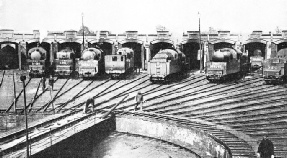
OIL-BURNING LOCOMOTIVES, by the engine sheds at Kavkazskaya Station. There are same 20,000 steam locomotives and twenty Diesel engines at present in operation on the lines of the Soviet Union Railways.
A great deal remains to be done to bring the Russian railway system up to date, but a great deal has been done already. Under the Imperialist rule, the principal lines were under the authority of the Russian State Railways. To-day there are no private companies at all; the entire railway system comes under the authority of a vast organization called the People’s Commissariat for Transport, which has supreme control of all ways and communications. The total mileage of railway route under its control, roughly 72,000, sounds large enough on first consideration. But there is room for an enormous amount of expansion in view of the area to be covered.
Immense tracts of fertile country and potentially rich industrial districts remain completely untapped, so, while in Great Britain, Belgium, Germany and France, there is little future for the extension of the existing railway systems, in Russia these conditions do not apply. The “Great Northern Route” is only one of many impressive possibilities. Russia to-day is in much the same position as the United States was in the ‘seventies of the last century. In years to come it will be interesting to compare the development of the American railways following the Civil War with the Russian railways following the Revolution.
The railway system to-day is split up into twenty-two Divisions, each distinguished by a name. Of these, the Perm Division is the largest, consisting as it does of 3,746 miles of railway route, all built to the 5-ft gauge. As its name implies, the head-quarters is at the city of Perm. Operating from the capital are the Moscow-Kazan, Moscow-Belorussk-Baltisk and Moscow-Kursk Divisions, with an aggregate mileage of 6,957 miles.
A particularly interesting division is that known as the Murmansk, for this penetrates far beyond the Arctic Circle to the ice-free port which gives it its name, outdistancing by far the railways of Alaska, and even the Swedish railway between Lulea and the Norwegian port of Narvik. This division has 1,115 miles of route. Unless the now disused mineral line in Spitzbergen is taken into consideration, the Murmansk Railway to-day holds pride of place as the most northerly railway in the world. Other arctic lines may be built in the future, this depending largely upon whether minerals are found in these regions.
Leaving the main line eastwards out of Leningrad, it strikes up past the eastern shores of the vast Lake Ladoga, the greatest sheet of fresh water in Europe, and after entering Karelia, reaches Petrozavodsk on Lake Onega. It crosses an arm of this lake to the north of Petrozavodsk and bears northwards, through wild country, into the basin of the River Vyg, serving the town of Soroka near the mouth.
The western shores of the White Sea are now skirted, and the Arctic Circle is crossed near the Gulf of Kandalaksha. Leaving this last arm of the White Sea, the line crosses the neck of the Kola peninsula, and reaches the desolation of the far northern tundra country. Murmansk is finally reached on the shores of the Arctic Ocean, the only railway terminus with such a situation.
Roughly parallel to the Murmansk line, though not attaining such a northerly latitude, is the shorter Archangelsk line, which runs due north from Vologda on the main line connecting Leningrad with the through trans-Siberian route. The country traversed is perhaps even more desolate than that found on the way to Murmansk. There are more than two hundred miles of practically straight track through the deserts of the Far North, the total distance from Vologda to Archangel being a little over 390 miles. Only one junction is encountered on the way, a place called Konosha.

72,000 MILES OF RAILWAY in Russia are now under the control of the People’s Commissariat for Transport. The chief gauge is 5 ft. The system is separated into twenty-two divisions, the largest of which has its headquarters at Perm, and has some 3,746 route miles built to the 5 ft gauge. Big schemes of electrification are in progress.
Of the Moscow-Leningrad line, now known as the October Railway, a curious story has been told. It is said that various interested persons had widely differing views as to the towns which should be served on the way, and there was a good deal of dissension on the subject. This was well back in the Imperialistic days. The Tsar heard of the wrangling, and decided to give his assent to the construction of the line in a remarkable manner.
The story reports that he called for a map, took a ruler, and drew a straight line between Moscow and what was then St. Petersburg, with the words: “Build it like that!” The line was certainly built near enough to this plan to give grounds for the story, and north of Bologoe, where it crosses the east-to-west line between Yaroslavl and Pskov, it is practically straight. It is almost level throughout, the steepest gradient being a stretch at roughly 1 in 1,660. It is fortunate that the Emperor did not try to apply his straight-line ideas to a projected route across the Caucasus Mountains in the South. Had he done so, Russia might now possess a railway tunnel beside which the Alpine tunnels would seem short and commonplace.
Reference to Imperial Russia reminds us that, when the Tsar travelled, elaborate precautions were taken to ensure his safety. It is characteristic of the Russian railways in the old days that in spite of this, a serious accident once befell the imperial train, and it was due, not to a revolutionary’s bomb, but to the bad state of the permanent way.
This was at Borki, in the south of Russia, in October, 1888. Four coaches were pitched down an embankment, and twenty-one of their occupants were killed. The Tsar, Alexander III, escaped with a shaking. A church was subsequently built at Borki to commemorate his escape.
Undoubtedly the most famous of all the existing Russian lines is the Trans-Siberian Railway, but as that has already received full attention in another chapter, we will now consider another spectacular piece of railway construction, the Turkestan-Siberian Division, or as it is always called, the Turksib. The Turksib begins at Novosibirsk on the Trans-Siberian line, and the first section of it is relatively old. The southern part, which passes through difficult and hitherto undeveloped country, is, however, one of the major railway enterprises of post-war Russia.
The line, as completed, provides a through route from Central Siberia right down through the wilds of Central Asia to Bokhara and Samarkand in the heart of Russian Turkestan. The traveller over this wonderful line, as he goes southwards, finds the skyline of the monotonous steppes being replaced by the distant mountains of the Tibetan frontier country. Samarkand itself, though its name sounds, perhaps, rather romantic, is a squalid clash between the East and the West.
On the one side are seen the destructive activities of political agitators, and on the other the Meuzzin calling the faithful to prayer. Workers’ flats jostle with mosques in various stages of disrepair, and a short walk can be taken from a Soviet cultural centre to the tomb of the great Mongolian king Tamerlane, who once bid fair to conquer the world. It is not, perhaps, rash to forecast great developments in north-eastern Siberia, especially in the vast basin of the River Lena. At the present time the important city of Yakutsk on the Lena is without railway communication, nor are there any railways in the immense territories beyond the Lena. Between the Lena and European Russia, the “Great Northern”, together with the subsidiary lines which will doubtless follow in its wake, should open up vast new regions for development. Nobody knows the extent of the mineral wealth in those northern lands.

SIDE-TIP WAGONS unloading spoil during the reconstruction of the Donbas-Moscow line, on which the gradients have been reduced and a second track added.
In their day the Russian railways must have seen practically every known type of locomotive. Although the country evolved definite national characteristics in the matter of locomotive design, Russia was an early purchaser of engines from foreign countries, including many from British builders. At one time the Glasgow firm of Sharp, Stewart & Co. built large numbers of eight-coupled goods engines, which were then among the biggest turned out of British workshops.
For the Transcaucasian lines around Baku, many of Fairlie’s patent double articulated locomotives were built at one time. These burnt crude petroleum, and as the fuel tanks were mounted on top of the boilers, the engines, with their central cabs and chimneys at either end, presented an odd appearance. They were subsequently superseded by standard eight-coupled tender locomotives of Russian design. Some of these engines were decidedly formidable in appearance, with gigantic “balloon” spark-arresters on the chimneys, and, not infrequently, two large domes, the leading one having the safety-valves on top. To these features were added the usual Russian railed-in gallery round the boiler and an enormous head-lamp.
When oil-burning engines were introduced on the lines in the Transcaucasian oil-fields, there were a good many alarmist objections about the possible consequences of spilt oil catching fire in an accident. Soon after, one of the locomotives under discussion ran off the line while descending an incline near Suram. The connexions between firebox and tender were severed - and the fire went out. It must be admitted, however, that there was a certain element of good luck about that accident. The consequences might easily have been otherwise.
20,000 Locomotives
To-day there are still many oil-burning locomotives at work in the south of Russia, certain of the modern standard types having been modified to take this type of fuel. At the same time, it is also possible that they will be superseded, perhaps within the next few years, by Diesel locomotives running directly on crude oil. There are already at least twenty Diesel locomotives at work on the southern lines, and experiments with Diesel traction have been carried out over a number of years. Recent figures show that the Soviet Union contains about 20,000 locomotives of various types. Naturally, complete standardization is still a good way off, for the locomotive stock left by the old Empire was amazing in its variety. Within the past ten years, however, definite steps have been taken in the matter of locomotive standardization, and some very fine types have been evolved.
The latest type of Russian express passenger locomotive is represented by the “Joseph Stalin”, named after the General Secretary of the Communist Party. She is an enormous machine with the 2-8-4 wheel arrangement, the after bogie giving extra support to the wide firebox. The railed-in gallery has at last been abandoned, the great diameter of the boiler rendering its inclusion well-nigh impossible.
The modern standard passenger locomotive for general service is the handsome 2-6-2 or “Prairie” class, illustrated in the chapter on the “Trans-Siberian Express”. These are of two main varieties; that illustrated on page 453 is a coal burner, but those which work in the south are oil-burners. The 2-6-2 type of engine is unusual in other countries, though there are a good many in Italy, and Hungary also possesses a fairly numerous class with this wheel arrangement.
Both Russia’s standard express passenger classes thus lack the leading bogie which, to-day, is a universal feature on nearly all locomotives intended for fast traffic elsewhere, although similar exceptions to this rule are found in the 2-8-2 express engines of Germany, the 2-6-4 and 2-8-4 types of Austria and Hungary, and the 2-8-2 “Cock o’ the North” class on the LNER, described in another chapter.
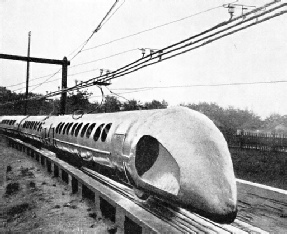
FUTURE DEVELOPMENTS are foreshadowed by this electric train which runs along on balls instead of wheels. This novel device was the idea of a young Soviet inventor. Experiments are reported to have given satisfactory results. The picture shows the experimental track.
The true giants among Russian loco-motives are found in the ranks of the goods engines; especially those which haul the immense coal and mineral trains from the Donetz Basin. The standard post-revolution goods engine for general service is of the 0-10-0 type, and there are hundreds of these, some having been built in Russia and others in Germany and Sweden. But on the heavy mineral trains mentioned above there are still bigger engines of the 2-10-2 and 2-10-4 types, with twelve-wheeled bogie tenders. These are of American origin, having been built by the Baldwin Locomotive Works and the American Locomotive Company respectively. In both types a four-coupled booster is mounted on the leading tender bogie, to assist the engines in getting their colossal loads under way. The weight of the 2-10-2 type is 273 tons, and that of the
2-10-4 is 286 tons.
Succeeding examples of these classes have been built in Russia, but a new type of Russian goods engine is even bigger, for this locomotive has the hitherto unknown 4-14-4 wheel arrangement. This is also intended for the Donetz Basin coal traffic.
In 1933 a rival to this huge fourteen-coupled engine appeared in the form of a British-built engine, an articulated “Beyer-Garratt’’ machine with the wheel arrangement formula 4-8-2 + 2-8-4. Designed and built at Manchester by Beyer, Peacock & Co, this magnificent locomotive is the largest ever built in European workshops.
When the engine was completed it was, naturally, too big for transport by rail in England, even had the rail-gauge been the same as that of Russia. The two power units, it is true, could be mounted up on heavy machinery wagons, but rail transport of the giant boiler from works to ship was out of the question. So the boiler was taken to the docks, very slowly and cautiously, on a motor lorry of maximum dimensions.
The weight of the engine in working order is 255 tons. Comparing this with the two American-built classes just described, it must be borne in mind that the given weights of the latter included the tenders. The “Garratt” engine is, in effect, a tank locomotive, and the greater part of its weight rests on the coupled wheels. A mechanical stoker is fitted, such a feature being absolutely necessary on a locomotive of this size.
To guard against the intense cold of the Russian winter, all the external steam-pipes are arranged to drain off, so that there is no fear of water remaining in them and freezing them up. The cab, too, is lined throughout with wood to protect the enginemen against the frost. The boiler does not look as big as it is, this dwarfing being enhanced by the relatively tall chimney, dome and sandbox. Being mounted between the two sets of wheels, instead of over them, it is pitched low. This huge steam-generator is 7 ft 5-in in diameter, and contains 4,781 sq ft of heating surface, while the grate area is no less than 86 sq ft. The boiler carries a working pressure of 220 lb per sq in, and supplies steam to four 22 7/16 by 28-in cylinders. The coupled wheels are 4 ft 11-in in diameter.
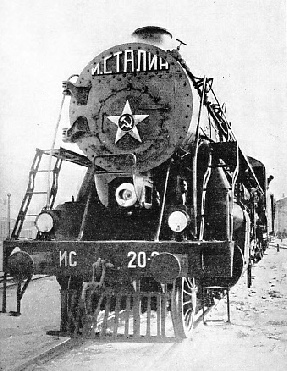
A FRONT VIEW OF THE “Joseph Stalin”, a new 2-8-4 express locomotive on the Soviet lines.
Turning to Russian passenger coaches, some much improved cars have recently been put into service on the Trans-Siberian line, and also on the shorter main lines from Moscow to Leningrad and Gorky (formerly Nijni Novgorod). The new cars for special services resemble those of the German Mitropa Company, though the generous construction gauge of the Russian lines makes them more roomy.
A feature of travel in the Russian “hard class” is the hiring of mattresses and bedclothes. The latter are brought to the passenger in a sealed bag, which is opened in his presence.
Russia has never been a country of great railway speeds. Trains are few and far between except in the isolated areas having a high population, and thus many towns have to be served by one train. The “October Express”, one of the best trains in Russia, covers the level 404½ miles from Moscow to Leningrad in exactly ten hours, calling at Tver and Bologoe.
The distance is practically the same as that from London to Edinburgh. The journey from Kiev to Odessa, 406 miles, occupies about fifteen hours, with stops at various places on the way. On this line, as well as on the October Railway, all the best trains run at night. From Moscow to Sevastopol, a distance of 954 miles, the journey time averages about thirty-eight hours, the trains running through Kharkov, which, though within 485 miles of Moscow, is about seventeen hours away. In certain localities train services have been considerably accelerated by electrification.
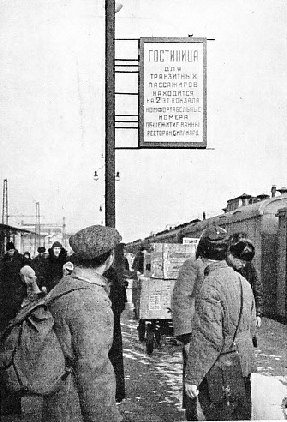
ARRIVAL IN MOSCOW. Travellers on a Moscow platform looking at a poster advertising a new railway hotel. This hotel is specially planned for passengers stopping only a night or so in the city. It can accommodate 155 people, but only ticket-holders have the right to stay there.
Electric railways are quite new to Russia, which had none before 1926. In that year, a beginning was made in the industrial area of Baku, with the 1,500-volt direct current system, overhead conductors being used. This system has since been standardized for the present and future electrification of steam railways, and for the extension of electric trunk lines.
Electrification in Russia
The Baku electrification is purely suburban, and covers the Baku-Mashtagi line, with branches from Sabrat to Pirshagi and from Sabunchi to Surahani. The trains consist of four-coach multiple-unit sets, each with two motor coaches. During the day, these run at half-hour intervals; and in the rush hour, eight-car trains, each consisting of two block sets, run every fifteen minutes.
Since the initial electrification of 1926, great extensions have been made in other parts of the Soviet Union, notably in the Moscow and Leningrad suburban areas, in the south, and in the industrial area of the Urals. Altogether nearly 300 miles are now electrically operated. For heavy traffic some fine twelve-wheeled electric locomotives have been introduced, these having been designed by the well-known firm of Brown-Boveri, in Italy.
The Moscow Underground Railway, or the “Metro”, as it is called, is fully described in the chapter beginning on page 894; but a few notes on this latest of underground railways may not be out of place here. The line is part of a separate scheme which owes its execution largely to the enterprise of L. M. Kaganovitch, the leading sponsor of advanced city transport in the Soviet Union. Its construction was sanctioned in 1931, the initial section being nearly eight miles long. Trains started running before the official opening, and guest passengers, including M. Stalin and Mr. Anthony Eden, made journeys on the railway.
In conclusion, it may be said that the railways have a very great future, not only in technical and scientific development, but also in the matter of extension, in the vast territories of Russia known to-day as the Soviet Union.
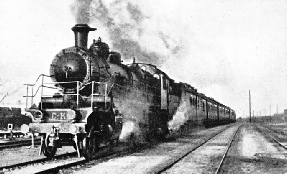
ON THE MOSCOW-LENINGRAD ROUTE. An express train on the main line, which is practically straight and level throughout. The greatest gradient is a twenty-miles section at 1 in 1,660. The “October Express”, one of the best Russian trains, covers the journey of 404½ miles between the two cities in ten hours, calling at Tver and Bologoe.
You can read more on
“Moscow’s Underground”,
“Russian Steam Locomotives”,
“The Trans-Caspian Railway” and
“The Trans-Siberian Express”
on this website.









